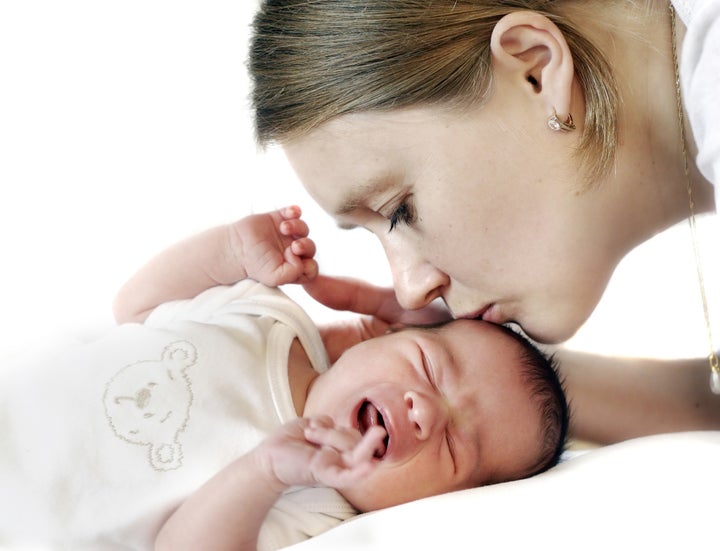
When a newborn infant screws up her face and lets loose with a full-throated wail, it's one of the most nerve-jangling sounds we can hear. Even worse is the eerie silence that can come between screams. When the howls go on and on, we instinctively want to do something to help. We want to make the crying stop.
But, what do we do after we've diapered, fed, swaddled, cuddled, rocked, sung, de-swaddled, re-diapered, bounced, swung and walked the floor? What do we do if we've emptied our entire bag of infant-calming tricks and nothing works?
Here's what we do. We hang in there. We do our best to stay calm. We keep trying.
Certainly, there are times when a pediatrician should be called for advice or a check-up to make sure nothing is physically wrong. But infants cry -- a lot -- for good reason, or sometimes for no apparent reason. Science tells us that even when we can't figure out what's wrong, our soft words and comforting touch still teach the infant this optimistic life lesson: When you're in distress, mom or dad or someone who loves you is going to stick by you, even when they don't have a clue what's troubling you.
The Fourth Trimester
When I say "infant" or "newborn," I mean a baby who is roughly three months old or younger. Infants that young are simply not neurologically or emotionally prepared to have their cries ignored. Later, they'll begin to figure out all the wonderful ways in which tears and sobs can manipulate their parents. But not yet.
Multiple branches of science, including evolutionary anthropology, neurology, biology and developmental psychology, tell us that the first three months of life is a crucial bridge from the comfortable world of the uterus to life in the world we all know. Think of it as the fourth trimester, a period of intense development in which infants have more in common with the fetuses they were than with the human babies they are becoming.
That's because human infants are unique in the animal world. They come to us with only 25 percent of their brains developed, the least neurologically prepared primate on earth. The brains of human newborns come equipped with more than enough neurons, but they don't yet have the brain wiring that allows for communication among the cells. Those communication networks begin to develop from day one with each sound, taste, blurry sight and comforting touch that comes their way.
Infants are helpless for sure, but they're also amazingly competent. At birth, they have only one communication tool at their disposal: their cry. It signals hunger, discomfort, fear, or lonelines -- all needs that were effortlessly met in the womb. Their very survival during the fourth trimester depends on their cry.
Something to Cry About
Think for a minute about what the world must look, sound, feel and smell like to a newborn baby. Put yourself in a neonate's place and imagine emerging from a cozy, temperature-controlled and highly personalized sac and suddenly landing in this chaotic world of ours. Everything formerly known and craved -- food, warmth, security -- has been left behind. Lights, noise, pokes and prods are alien and harsh. Exhausted from the birth rides, infants take their first breath and exhale a vigorous cry of life.
Repetition is Boring, Even when You're a Week Old
It's our job to ease them through this time of transition by responding to cries and trying to give them what they need. When the need isn't food, a diaper change, relief from being too hot or too cold or other obvious necessities, we're stymied. I don't believe that there is a magic formula for comforting every baby every time. One infant might calm down when swaddled while another hates the tight wrap. One might find comfort in quiet darkness while another quiets down to the sound of a lullaby.
One father told me that he was sure he found the perfect routine to soothe his infant son. He ran water in the shower, while cuddling the baby as he bounced on an exercise ball in the bathroom. The combination of dim light, the sound of water, the bouncing motion and the security of being in his father's arms was just the ticket. It worked on day one. It worked again on days two and three. The parents were delighted, and the father felt like a child-care genius.
Then came day four, and the shower bouncing routine no longer worked. The baby continued to be inconsolable as his father bounced away and the water ran down the drain. We've all had similar experiences. We find a certain way of holding brings peace and are sure that a football hold, for example, is the ticket; or a cradle hold; or an over the shoulder hold. We think the answer is to face the infant forward or backward or sideways or face down on our laps. It works once or twice, then stops working.
The truth is, babies are like the rest of us. Something pleases them one minute, they lose interest the next. Babies get bored, too. Silence works one day, a lullaby the next. Rocking one day, laying them down while rubbing their backs the next. It's an ongoing experiment, and your efforts to understand represent the first days of what will become a lifelong communication based on observation and love. The best you can do is pay attention to their signals day by day.
When an infant cries, he has a need. You know how to check a diaper or prepare a feeding. But loneliness is also a need for a brand-new human being who, for nine months, has never been alone. So hang in there. Let them know that you've got the parental chops to see them through distress. Let their most early experiences in life show them that, just as their biological mothers were right there with them through the three trimesters of pregnancy, someone who loves them is going to be right by their side through the crucial fourth trimester of development.
EARLIER ON HUFFPOST PARENTS
